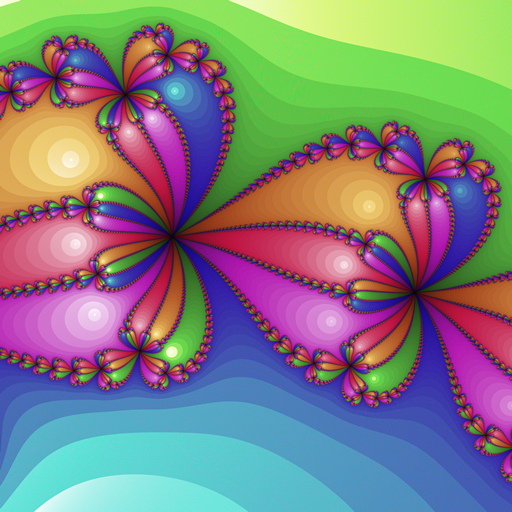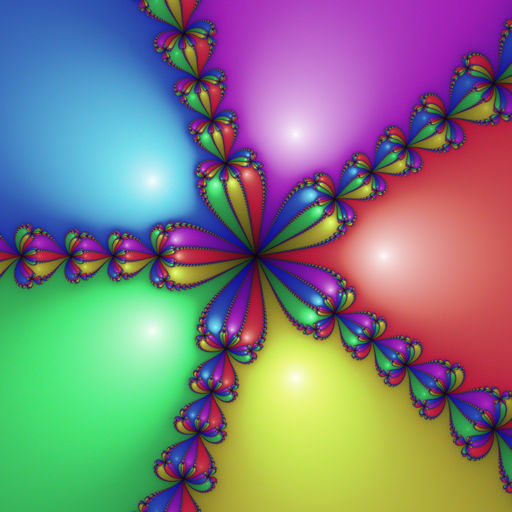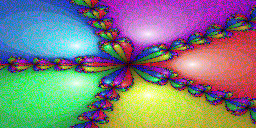This is based on a Newtonian Fractal, specifically for z → z5 - 1. Because there are five roots, and thus five convergence points, the available color space is split into five regions, based on Hue. The individual points are sorted first by number of iterations required to reach their convergence point, and then by distance to that pointand then by distance to that point, with earlier values being assigned a more luminous color.
 Update 2: Because Newton's iteration converges quadratically, it's possible to compute non-integer convergence numbers, by adjusting by the log of the distance to the convergence point, divided by the log of the threshold. This creates a smooth gradient, without any noticeable rings.
Update 2: Because Newton's iteration converges quadratically, it's possible to compute non-integer convergence numbers, by adjusting by the log of the distance to the convergence point, divided by the log of the threshold. This creates a smooth gradient, without any noticeable rings.
Original (3344.72 MB)






from __future__ import division
from PIL import Image, ImageDraw
from cmath import phase
from sys import maxint
dim = (4096, 4096)
bits = 8
def RGBtoHSV(R, G, B):
R /= 255
G /= 255
B /= 255
cmin = min(R, G, B)
cmax = max(R, G, B)
dmax = cmax - cmin
V = cmax
if dmax == 0:
H = 0
S = 0
else:
S = dmax/cmax
dR = ((cmax - R)/6 + dmax/2)/dmax
dG = ((cmax - G)/6 + dmax/2)/dmax
dB = ((cmax - B)/6 + dmax/2)/dmax
if R == cmax: H = (dB - dG)%1
elif G == cmax: H = (1/3 + dR - dB)%1
elif B == cmax: H = (2/3 + dG - dR)%1
return (H, S, V)
cmax = (1<<bits)-1
cfac = 255/cmax
img = Image.new('RGB', dim)
draw = ImageDraw.Draw(img)
xstart = -2
ystart = -2
xd = 4 / dim[0]
yd = 4 / dim[1]
tol = 1e-12
a = [[], [], [], [], []]
for x in range(dim[0]):
print x, "\r",
for y in range(dim[1]):
z = d = complex(xstart + x*xd, ystart + y*yd)
c = 0
l = 1
while abs(l-z) > tol and abs(z) > tol:
l = z
z -= (z**5-1)/(5*z**4)
c += 1
if z == 0: c = maxint
p = int(phase(z))
a[p] += (c,abs(d-z), x, y),
for i in range(5):
a[i].sort(reverse = False)
pnum = [len(a[i]) for i in range(5)]
ptot = dim[0]*dim[1]
bounds = []
lbound = 0
for i in range(4):
nbound = lbound + pnum[i]/ptot
bounds += nbound,
lbound = nbound
t = [[], [], [], [], []]
for i in range(ptot-1, -1, -1):
r = (i>>bits*2)*cfac
g = (cmax&i>>bits)*cfac
b = (cmax&i)*cfac
(h, s, v) = RGBtoHSV(r, g, b)
h = (h+0.1)%1
if h < bounds[0] and len(t[0]) < pnum[0]: p=0
elif h < bounds[1] and len(t[1]) < pnum[1]: p=1
elif h < bounds[2] and len(t[2]) < pnum[2]: p=2
elif h < bounds[3] and len(t[3]) < pnum[3]: p=3
else: p=4
t[p] += (int(r), int(g), int(b)),
for i in range(5):
t[i].sort(key = lambda c: c[0]*2126 + c[1]*7152 + c[2]*722, reverse = True)
r = [0, 0, 0, 0, 0]
for p in range(5):
for c,d,x,y in a[p]:
draw.point((x,y), t[p][r[p]])
r[p] += 1
img.save("out.png")
from __future__ import division
from PIL import Image, ImageDraw
from cmath import phase
from sys import maxint
from math import log10
dim = (4096, 4096)
bits = 8
def RGBtoHSV(R, G, B):
R /= 255
G /= 255
B /= 255
cmin = min(R, G, B)
cmax = max(R, G, B)
dmax = cmax - cmin
V = cmax
if dmax == 0:
H = 0
S = 0
else:
S = dmax/cmax
dR = ((cmax - R)/6 + dmax/2)/dmax
dG = ((cmax - G)/6 + dmax/2)/dmax
dB = ((cmax - B)/6 + dmax/2)/dmax
if R == cmax: H = (dB - dG)%1
elif G == cmax: H = (1/3 + dR - dB)%1
elif B == cmax: H = (2/3 + dG - dR)%1
return (H, S, V)
cmax = (1<<bits)-1
cfac = 255/cmax
img = Image.new('RGB', dim)
draw = ImageDraw.Draw(img)
xstart = -2
ystart = -2
xd = 4 / dim[0]
yd = 4 / dim[1]
tol = 1e-6
a = [[], [], [], [], []]
for x in range(dim[0]):
print x, "\r",
for y in range(dim[1]):
z = d = complex(xstart + x*xd, ystart + y*yd)
c = 0.0
l = 1
while abs(l-z) > tol and abs(z) > tol:
l = z
z -= (z**5-1)/(5*z**4)
c += 1.0
if z == 0: c = maxint
p = int(phase(z))
if abs(l-z) > 0.0:
c += log10(abs(l-z)) / 6
a[p] += (c, x, y),
for i in range(5):
a[i].sort(reverse = False)
pnum = [len(a[i]) for i in range(5)]
ptot = dim[0]*dim[1]
bounds = []
lbound = 0
for i in range(4):
nbound = lbound + pnum[i]/ptot
bounds += nbound,
lbound = nbound
t = [[], [], [], [], []]
for i in range(ptot-1, -1, -1):
r = (i>>bits*2)*cfac
g = (cmax&i>>bits)*cfac
b = (cmax&i)*cfac
(h, s, v) = RGBtoHSV(r, g, b)
h = (h+0.1)%1
if h < bounds[0] and len(t[0]) < pnum[0]: p=0
elif h < bounds[1] and len(t[1]) < pnum[1]: p=1
elif h < bounds[2] and len(t[2]) < pnum[2]: p=2
elif h < bounds[3] and len(t[3]) < pnum[3]: p=3
else: p=4
t[p] += (int(r), int(g), int(b)),
for i in range(5):
t[i].sort(key = lambda c: c[0]*2126 + c[1]*7152 + c[2]*722, reverse = True)
r = [0, 0, 0, 0, 0]
for p in range(5):
for c,x,y in a[p]:
draw.point((x,y), t[p][r[p]])
r[p] += 1
img.save("out.png")





